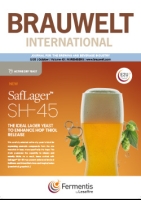Hite Brewery in South Korea developed a Korean beer brand and conquered the domestic beer market. Quality improvements, rationalization and a successful take-over policy led to an international presence of the company in 19 countries. The situation in the South Korean beer market, the strategies and equipment of the brewery are described in the following.
When the going gets tough, the tough get going. While the major brewers seem determined to compete heads-on in a fierce price war, even at the risk of running the domestic beer category into the ground, it’s mostly thanks to the once derided beer geeks and hop heads that beer continues to excite – at least three percent of the American population.
Prompted by an agreement with the government the Dutch brewers set out to develop a method to establish a worldwide benchmark in specific energy consumption for the brewing industry. In total more than 100 breweries from 38 countries participated in this energy benchmark. The study shows that 10% of the participating breweries have a specific energy consumption lower than 193 MJ/hl.
A company’s success is based on targeted communication of brands to arouse consumer desires. Along with TV and press advertising, the beverage trade generally relies on intensive sport sponsoring and sales promotion at the point of sale. The growing willingness to invest in a brand is documented, for example, by the number of new television beverage commercials during the year 2000.
Product life cycles are getting shorter. The pace of innovation is continuously accelerating, consumers are harder to please. Products in the beverage sector are becoming more demanding technologically. At an early stage of an innovation project, it is essential that producers and suppliers get together and discuss the overall project, including possible opportunities and challenges.
In cooperation with the Institut für Analytik and Schwachstellenforschung (IAS) (Institute for Analysis and Weak Point Research) in Mannheim, KHS has developed a dynamic availability controlled condition-related maintenance system ZIS for company-supplied machines and plants.
This paper given at the 2000 Bamberg Marketing Symposium looks at the potential and limits of visions. Starting with the achievements of the industrial revolution, trends are identified and their implications considered.
What will the future bring for the brewing industry? Which way will the industry be heading - towards the valley of tears, to its Waterloo in the doldrums? Or will it be towards the rainbow’s end, the happy land, the light at the end of the tunnel? With the year 2000 looming large, we decided to use the opportunity for an assessment and asked members of the international brewing industry to share their thoughts and ideas with us. The statements which we received and which are collected here represent a wide range of subjects and opinions. Some focus on specific markets or on technical issues, others on marketing or general issues. As was to be expected, some are more optimistic, others more critical. However, all are sincerely concerned for the future of the brewing industry and its people, be they on the production side or the consumption side in the general scheme of things. That is why we would like to thank our respondents for their courage and willingness to voice their opinions in these highly competitive times of ours. We also note with great regret that distinguished Professor Masschelein passed away after submitting his statement. We are grateful to be able to publish his valued contribution here.
Part II of this paper explores how technology innovation has had some recent successes in helping create new brands (with some examples given).


